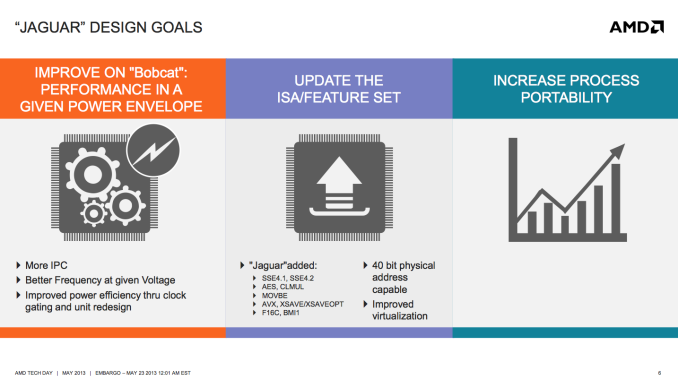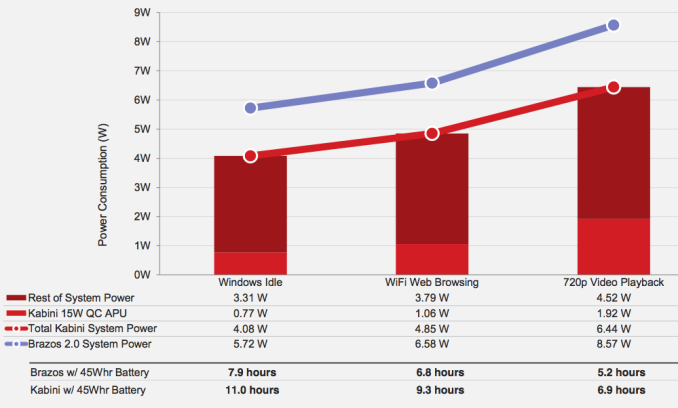AMD’s Jaguar Architecture: The CPU Powering Xbox One, PlayStation 4, Kabini & Temash
by Anand Lal Shimpi on May 23, 2013 12:00 AM ESTFinal Words
Bobcat was a turning point for AMD. The easily synthesized, low cost CPU design was found in the nearly 50 million Brazos systems AMD sold since its introduction. Jaguar improves upon Bobcat in a major way. The move to 28nm helps drive power even lower, which will finally get AMD into tablet designs with Temash. Despite being lower power, Jaguar also manages to increase performance appreciably over Bobcat. AMD claims up to a 22% increase in IPC compared to Bobcat. Combine the IPC gains with a more multi-core friendly design and Jaguar based APUs should be appreciably faster than their predecessors.
Quite possibly one of the only real weaknesses with Jaguar is the lack of aggressive turbo modes in any of the shipping implementations of the design. It appears that the first implementations of Jaguar were under time constraints, leaving many features (including improved thermal monitoring/management and turbo boost) on the cutting room floor. Kabini and Temash seem ripe for a mid-cycle update enabling turbo across more parts, which could do wonders for single threaded performance.
The Jaguar power story actually looks very good, it's just hampered by traditional PC legacy. None of the launch APUs here support the low power IOs necessary to drive platform power down even further. AMD is getting very close though. Jaguar's core power is easily sub-2W for lightweight tablet tasks, the rest of the platform (excluding display) drives it up to 4 - 7W. AMD definitely has the right building blocks to go after truly low power tablets in a major way, should it have the resources and bandwidth to do so.
In its cost and power band, Jaguar is presently without competition. Intel’s current 32nm Saltwell Atom core is outdated, and nothing from ARM is quick enough. It’s no wonder that both Microsoft and Sony elected to use Jaguar as the base for their next-generation console SoCs, there simply isn’t a better option today. As Intel transitions to its 22nm Silvermont architecture however Jaguar will finally get some competition. For the next few months though, AMD will enjoy a position it hasn’t had in years: a CPU performance advantage.
I can’t stress enough how important it is that AMD continues to focus on driving the single threaded performance of its cat-line of cores. Second chances are rare in this business, but that’s exactly what AMD has been offered with the rise of good enough computing. Jaguar vs. Atom is the best CPU story AMD has had in years. Regular updates to the architecture coupled with solid execution are necessary to ensure that history doesn’t repeat itself in a new segment of AMD’s business.
Long term, I can’t help but wonder what Bobcat’s success will do to shape AMD’s future microarchitecture decisions. I’m not sure what Jim Keller’s SoC project is, but I’m wondering if the days of really big cores might be over. I don’t know that really small cores are the answer either, but perhaps something in between...












78 Comments
View All Comments
vision33r - Thursday, May 23, 2013 - link
Real shame is that AMD has not gotten into the mobile market at all. APUs like this would've been great for tablets.jeffkibuule - Thursday, May 23, 2013 - link
Even if AMD makes the chip, and OEM has to be willing to use it.duploxxx - Thursday, May 23, 2013 - link
exactly the problem, current atom is a horrible cpu in wathever device, whatever frequency you put it. have used them in notebooks and even now in a tablet. Bobcat on the other hand was awesome in the netbook range. THe temash would be way better suited for all these devices but as usual OEM focus on the blue brand with market jingles and dominancy and in the end its the end consumer (WE) that suffer from it and if it continues like this we will even suffer more. (less innovative, higher prices, dominant predefined design (something already horrible today) but many people fail to see that........as if they think there Intel system they just bought is a better suited device for everything...mganai - Thursday, May 23, 2013 - link
Intel's been going easy on AMD these past few years.Plus, Atom is finally due for its big update this year, following which we'll be seeing a more frequent update schedule in line with their Core processors.
The heterogeneous solution was what won the PS4 and XB1 for AMD.
thebeastie - Saturday, May 25, 2013 - link
Simple, Money! Why roll as fast as you can when your already the fastest and aren't going to be bringing any more money then you are now.Bobs_Your_Uncle - Saturday, May 25, 2013 - link
I'd read an interesting perspective on why Intel refrained from "kicking AMD to the curb & on down into the storm sewer" (sorry; can't recall the source). In essence, given the scope of Intel's unquestioned dominance in their chosen markets, (& mobile's on the radar), were they to act with any obvious & direct intent to further weaken, (or even try & finish off), AMD, Intel would find themselves in an extremely difficult, exceedingly complex & decidedly unpleasant set of circumstances.By decimating their only possible source of true competition, Intel would be responsible for invoking upon themselves intense anti-trust scrutiny; a result that would be inevitable assuming regulatory agencies were functioning properly.
By backing off a bit, Intel may well cede some amount of business to AMD, but they retain a legitimate market competitor & at the same time continue collecting very healthy margins. The premiums charged on sales can then be used to continue funding aggressive Intel R&D, and, uh, marketing related expenditures, too.
spartaman64 - Wednesday, June 4, 2014 - link
for a company that could "kick amd to the curb" intel is awfully nervous about amd's kaveriWolfpup - Wednesday, June 12, 2013 - link
Yeah, but regardless AMD's had the FAR better CPU now for years. I've been running the lowest end version of it for a couple of years in a tiny notebook, and from the beginning wished people were using it for tablets.Flunk - Friday, June 6, 2014 - link
When you say current Atom, are you referring to Baytrail? Previous Atoms were pretty bad for Windows boxes, in my personal experience. But the new generation is significantly more powerful (About on par with a Core 2 Duo on benchmarks). They seem pretty reasonable for basic office tasks, this may not include all the lowest-end versions.Flunk - Friday, June 6, 2014 - link
NVM, followed the wrong link and didn't see the date. Thought this was about something else. May 2013 Atoms sucked.